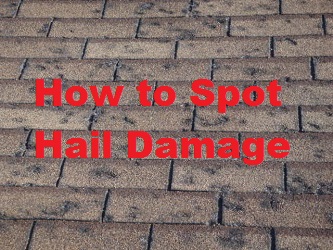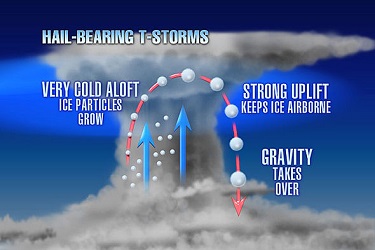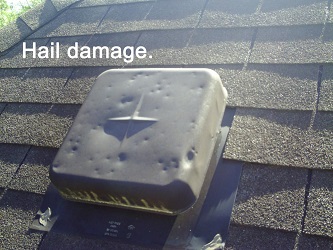How To Spot Hail Damage
 When it comes to hail, it can be a very problematic issue with your home or vehicle. In most cases, hail is simply an irritating event when ice has formed into very small droplets and showers down on the earth. However, there are times in which hail can become much larger, reaching golf ball or baseball size and larger before plummeting to the ground. When this happens, hail becomes far more than a nuisance and actually becomes a threat to life and property.
When it comes to hail, it can be a very problematic issue with your home or vehicle. In most cases, hail is simply an irritating event when ice has formed into very small droplets and showers down on the earth. However, there are times in which hail can become much larger, reaching golf ball or baseball size and larger before plummeting to the ground. When this happens, hail becomes far more than a nuisance and actually becomes a threat to life and property.
Understanding how to spot hail damage on your home and vehicle is very important if you have coverage or want to sell your house or automobile. There are certain locations in the United States, particularly the plain states that reach from North Dakota down to Texas and also include Colorado and Wyoming where hail can be particularly problematic.
When you are faced with the prospect of how to spot hail damage, it is important to understand why it forms, when it comes down and what kind of damage it can cause.
What is Hail?
Hail is created when the moisture in the atmosphere during a rain is driven upwards by the high winds of a large thunderstorm where it freezes and then comes down. Most occurrences of hail happens during large, fast moving thunderstorms that often feature high winds and some have wind circulation that may create conditions for a tornado. Quite often, hail signals the end phase of a storm as it passes through an area.
Places like Colorado, Nebraska and Wyoming have the most recorded hail storms and are called “hail alley” because of this phenomenon. There is an average of eight days of hail each year when it comes to these storms. However, hail can happen anywhere and you should prepare as much as possible when the chances arise. This means parking your vehicles inside or under shelter if at all possible.
However, not everyone has a place to park their vehicles which is safe from hail and quite often it can happen unexpectedly. So, if your vehicle was caught out in the hail even if it was seemingly small, they can cause a considerable amount of damage. Every year, hail causes over a billion dollars in property damage which includes automobiles.
How to Spot Hail Damage to Your Vehicle and Home
After a hail storm, even if you think there was no damage it pays to make a quick inspection to see if something did occur.
Check for Dents, Cracks and Breaks: You should first check all vehicles that were out in the storm and then move to the windows, screens and doors of your home. Also, if you have any patio furniture you can check that as well for any damage.
Outdoor Appliances: Central air conditioning units and window units should be checked for any dents or damage. Plus, check to see if there is an excessive amount of water present in or around the unit.
Look for Tree Branches and Plant Damage: If you step outside and see tree branches in the yard, chances are that your location has experienced hail and high winds which can damage your roof as well as anything else outdoors. This is a sign that you should do a more thorough check for damage around your home.
Roof: Even if you have a metal roof, you’ll still want to check it for any damage from the storm. Check to see if any shingles have loosened or fallen off as well as any cracks around chimneys, pipes and the corners of the roof as well. Remember that you should not go up on your roof because that will expose you to unnecessary danger. Instead, use binoculars or call a professional who can provide you with a roof inspection.
How to Take Action if You Should Find Hail Damage
Now that you know how to spot hail damage, the next step is what to do when you find it. Basically, the sooner you take action, the better off you will be as further rain and hail will only worsen the damage to your home or vehicle. This will mean if there are any cracked or broken windows that you’ll need to cover them with tarp so that no more moisture will get inside.
Take Pictures of All Hail Damage: Before you put up the tarp or make any temporary repairs to your home or vehicle, take pictures of the damage itself as this will be important for your insurance claim. After the photos are taken, you can then make the temporary repairs.
Contact Insurance Agency: One you have assessed all the damage, contact your insurance agency to find out what is covered on your policy and how to go about filing a claim when ready. In most cases, you will have to pay for the repairs up front and they will reimburse you afterwards.
Hire a Respectable Contractor: It’s always a good idea to check out a contractor beforehand so that you can go with one that can be trusted. Hail storms in particular seem to bring out the disreputable contractors who will charge very high fees and not do a proper job. If you have not secured the services of a respectable contractor before, you can start with family and friends who can recommend one for you and then do a web search to see if they are licensed in the area and have a good reputation.
Save the Receipts: Always remember to save the receipts and use them for your insurance claim. That way, you’ll have an official record and it pays to make duplicate copies of the receipts as well.
Knowing how to spot hail damage can help you get it repaired quickly and file the proper insurance claim so that your home or vehicle is protected.
Privacy Policy: We hate SPAM and promise to keep your email safe.

